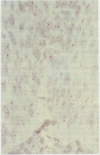Abstract
In South Africa asymptomatic wart virus infection diagnosed by morphological criteria occurs in 16-20% of all ethnic groups; the incidence in black women is 66%. To identify human papillomavirus (HPV) types the prevalence of HPV in cervical intraepithelial neoplasia (CIN) in South African women (n = 72) with age matched British women (n = 73) was compared by non-isotopic in situ hybridisation (NISH) using digoxigenin labelled probes for HPV 6, 11, 16, 18, 31, 33 and 35 on archival biopsy specimens. A higher proportion of British biopsy specimens (68%) contained HPV than those from South Africa (50%) in CIN 2 and 3; this difference was due to HPV 16. Thirty six per cent of the positive biopsy specimens from South African women also contained HPV 33/35 compared with 16% in the United Kingdom. There was no difference in HPV detection with age in either group. These data indicate that HPV types vary geographically, with "minor" HPV types being more common in South Africa. Three qualitatively distinct NISH signals were observed; a diffuse (type 1) signal in superficial cells, mainly koilocytes; a punctate signal (type 2) in basal/"undifferentiated" cells in CIN 3; and combined type 1 and 2 signals in CIN with wart virus infection (type 3). The punctate signal may represent HPV integration.
Full text
PDF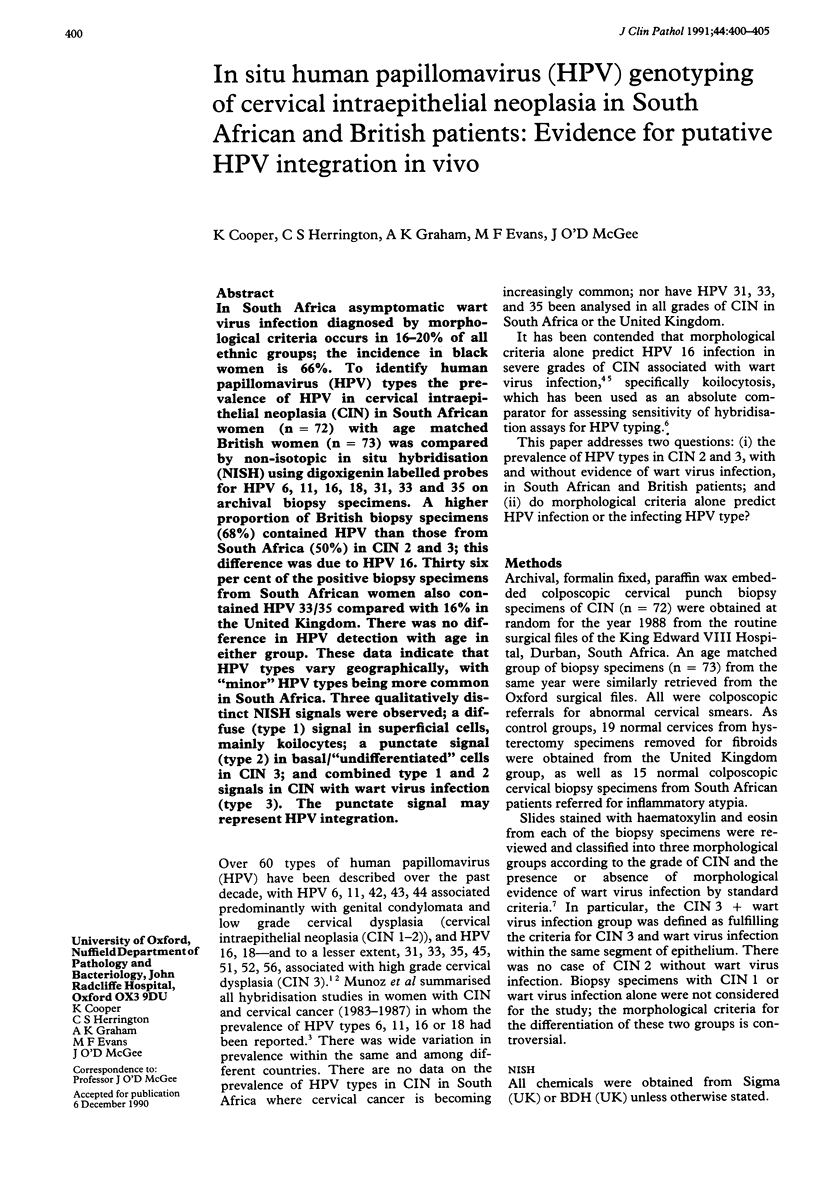
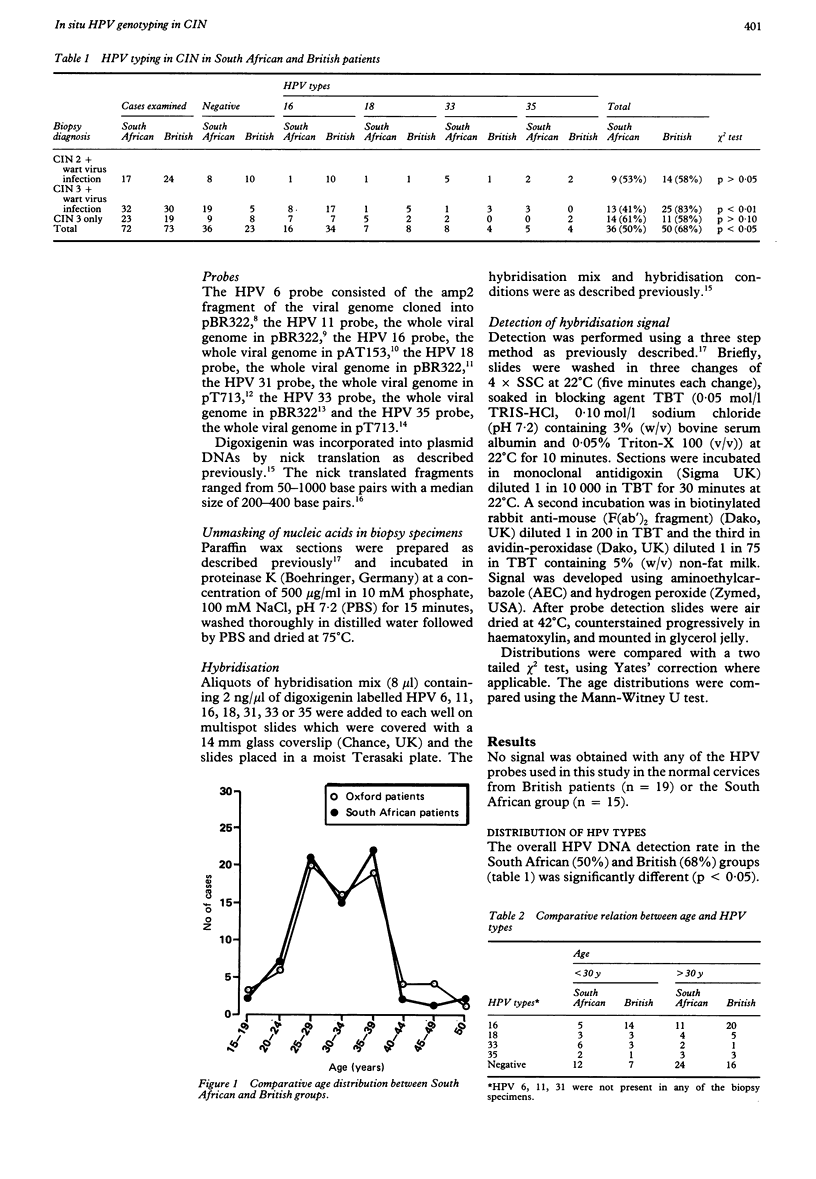
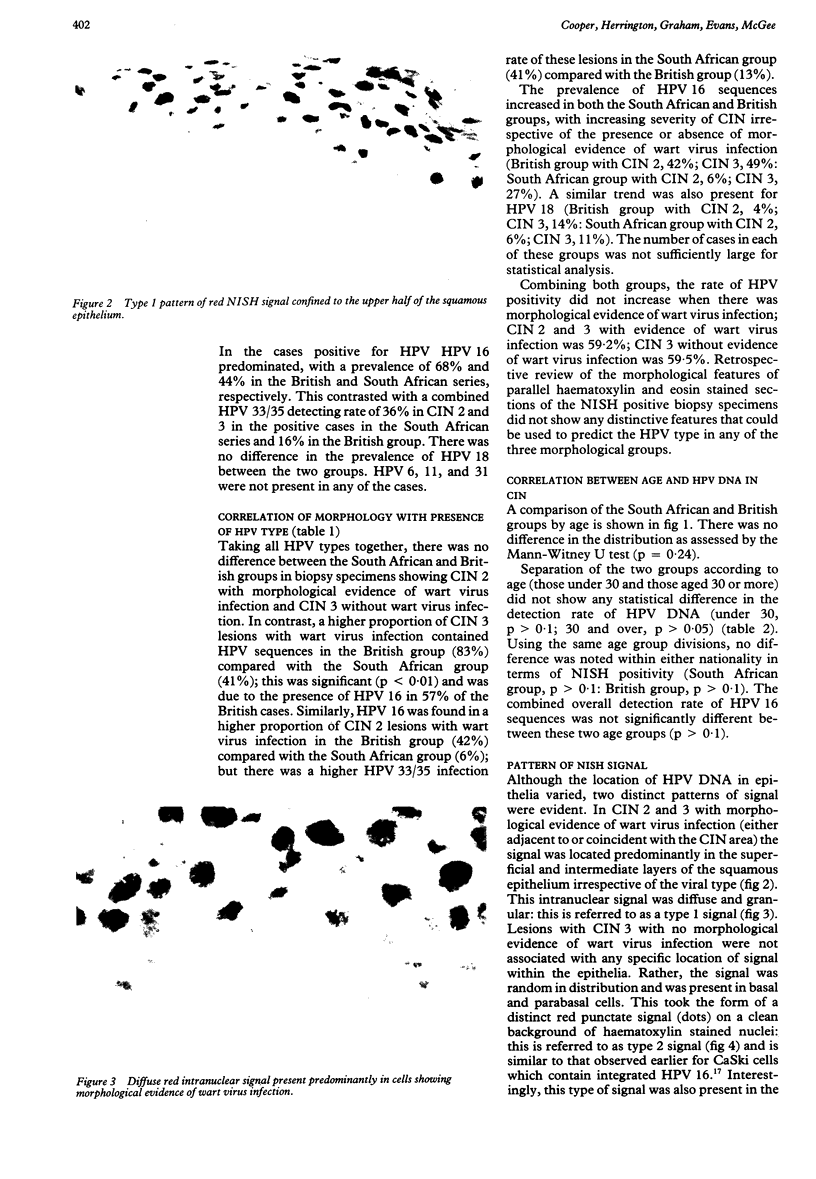
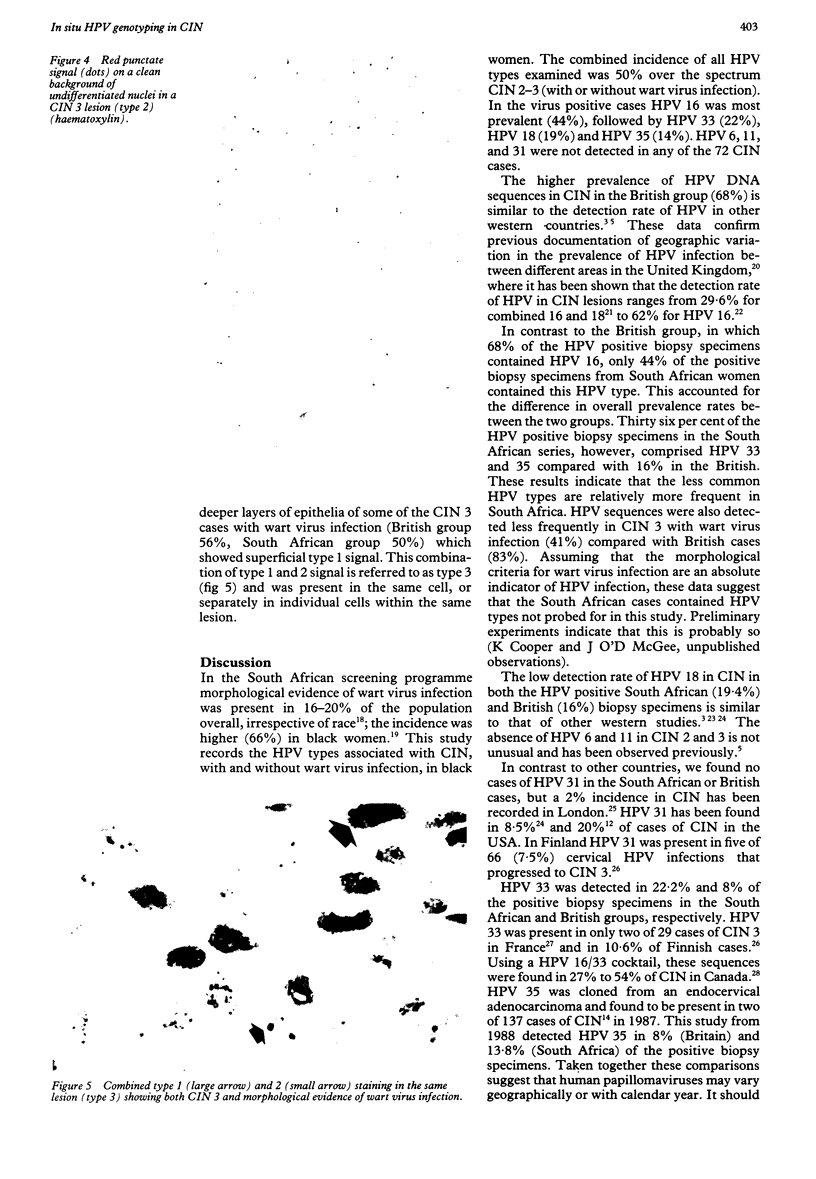
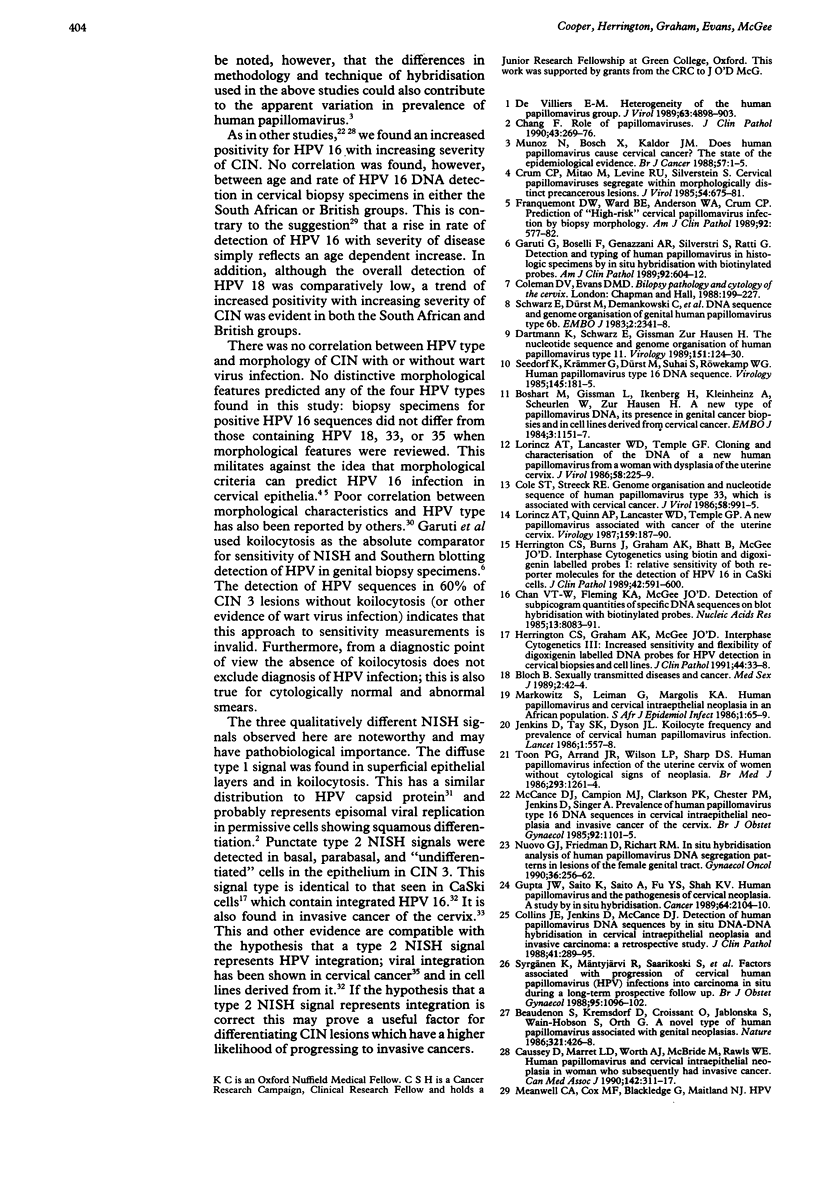

Images in this article
Selected References
These references are in PubMed. This may not be the complete list of references from this article.
- Chan V. T., Fleming K. A., McGee J. O. Detection of sub-picogram quantities of specific DNA sequences on blot hybridization with biotinylated probes. Nucleic Acids Res. 1985 Nov 25;13(22):8083–8091. doi: 10.1093/nar/13.22.8083. [DOI] [PMC free article] [PubMed] [Google Scholar]
- Chang F. Role of papillomaviruses. J Clin Pathol. 1990 Apr;43(4):269–276. doi: 10.1136/jcp.43.4.269. [DOI] [PMC free article] [PubMed] [Google Scholar]
- Cole S. T., Streeck R. E. Genome organization and nucleotide sequence of human papillomavirus type 33, which is associated with cervical cancer. J Virol. 1986 Jun;58(3):991–995. doi: 10.1128/jvi.58.3.991-995.1986. [DOI] [PMC free article] [PubMed] [Google Scholar]
- Collins J. E., Jenkins D., McCance D. J. Detection of human papillomavirus DNA sequences by in situ DNA-DNA hybridisation in cervical intraepithelial neoplasia and invasive carcinoma: a retrospective study. J Clin Pathol. 1988 Mar;41(3):289–295. doi: 10.1136/jcp.41.3.289. [DOI] [PMC free article] [PubMed] [Google Scholar]
- Crum C. P., Mitao M., Levine R. U., Silverstein S. Cervical papillomaviruses segregate within morphologically distinct precancerous lesions. J Virol. 1985 Jun;54(3):675–681. doi: 10.1128/jvi.54.3.675-681.1985. [DOI] [PMC free article] [PubMed] [Google Scholar]
- Dartmann K., Schwarz E., Gissmann L., zur Hausen H. The nucleotide sequence and genome organization of human papilloma virus type 11. Virology. 1986 May;151(1):124–130. doi: 10.1016/0042-6822(86)90110-8. [DOI] [PubMed] [Google Scholar]
- Dürst M., Kleinheinz A., Hotz M., Gissmann L. The physical state of human papillomavirus type 16 DNA in benign and malignant genital tumours. J Gen Virol. 1985 Jul;66(Pt 7):1515–1522. doi: 10.1099/0022-1317-66-7-1515. [DOI] [PubMed] [Google Scholar]
- Franquemont D. W., Ward B. E., Andersen W. A., Crum C. P. Prediction of 'high-risk' cervical papillomavirus infection by biopsy morphology. Am J Clin Pathol. 1989 Nov;92(5):577–582. doi: 10.1093/ajcp/92.5.577. [DOI] [PubMed] [Google Scholar]
- Garuti G., Boselli F., Genazzani A. R., Silvestri S., Ratti G. Detection and typing of human papillomavirus in histologic specimens by in situ hybridization with biotinylated DNA probes. Am J Clin Pathol. 1989 Nov;92(5):604–612. doi: 10.1093/ajcp/92.5.604. [DOI] [PubMed] [Google Scholar]
- Graham A. K., Herrington C. S., McGee J O. Simultaneous in situ genotyping and phenotyping of human papillomavirus cervical lesions: comparative sensitivity and specificity. J Clin Pathol. 1991 Feb;44(2):96–101. doi: 10.1136/jcp.44.2.96. [DOI] [PMC free article] [PubMed] [Google Scholar]
- Gupta J. W., Saito K., Saito A., Fu Y. S., Shah K. V. Human papillomaviruses and the pathogenesis of cervical neoplasia. A study by in situ hybridization. Cancer. 1989 Nov 15;64(10):2104–2110. doi: 10.1002/1097-0142(19891115)64:10<2104::aid-cncr2820641022>3.0.co;2-n. [DOI] [PubMed] [Google Scholar]
- Herrington C. S., Burns J., Graham A. K., Evans M., McGee J. O. Interphase cytogenetics using biotin and digoxigenin labelled probes I: relative sensitivity of both reporter molecules for detection of HPV16 in CaSki cells. J Clin Pathol. 1989 Jun;42(6):592–600. doi: 10.1136/jcp.42.6.592. [DOI] [PMC free article] [PubMed] [Google Scholar]
- Kadish A. S., Burk R. D., Kress Y., Calderin S., Romney S. L. Human papillomaviruses of different types in precancerous lesions of the uterine cervix: histologic, immunocytochemical and ultrastructural studies. Hum Pathol. 1986 Apr;17(4):384–392. doi: 10.1016/s0046-8177(86)80462-2. [DOI] [PubMed] [Google Scholar]
- Lorincz A. T., Lancaster W. D., Temple G. F. Cloning and characterization of the DNA of a new human papillomavirus from a woman with dysplasia of the uterine cervix. J Virol. 1986 Apr;58(1):225–229. doi: 10.1128/jvi.58.1.225-229.1986. [DOI] [PMC free article] [PubMed] [Google Scholar]
- Lorincz A. T., Quinn A. P., Lancaster W. D., Temple G. F. A new type of papillomavirus associated with cancer of the uterine cervix. Virology. 1987 Jul;159(1):187–190. doi: 10.1016/0042-6822(87)90366-7. [DOI] [PubMed] [Google Scholar]
- McCance D. J., Campion M. J., Clarkson P. K., Chesters P. M., Jenkins D., Singer A. Prevalence of human papillomavirus type 16 DNA sequences in cervical intraepithelial neoplasia and invasive carcinoma of the cervix. Br J Obstet Gynaecol. 1985 Nov;92(11):1101–1105. doi: 10.1111/j.1471-0528.1985.tb03019.x. [DOI] [PubMed] [Google Scholar]
- Meanwell C. A., Cox M. F., Blackledge G., Maitland N. J. HPV 16 DNA in normal and malignant cervical epithelium: implications for the aetiology and behaviour of cervical neoplasia. Lancet. 1987 Mar 28;1(8535):703–707. doi: 10.1016/s0140-6736(87)90353-9. [DOI] [PubMed] [Google Scholar]
- Mincheva A., Gissmann L., zur Hausen H. Chromosomal integration sites of human papillomavirus DNA in three cervical cancer cell lines mapped by in situ hybridization. Med Microbiol Immunol. 1987;176(5):245–256. doi: 10.1007/BF00190531. [DOI] [PubMed] [Google Scholar]
- Muñoz N., Bosch X., Kaldor J. M. Does human papillomavirus cause cervical cancer? The state of the epidemiological evidence. Br J Cancer. 1988 Jan;57(1):1–5. doi: 10.1038/bjc.1988.1. [DOI] [PMC free article] [PubMed] [Google Scholar]
- Nuovo G. J., Friedman D., Richart R. M. In situ hybridization analysis of human papillomavirus DNA segregation patterns in lesions of the female genital tract. Gynecol Oncol. 1990 Feb;36(2):256–262. doi: 10.1016/0090-8258(90)90184-m. [DOI] [PubMed] [Google Scholar]
- Rathjen F. G., Schachner M. Immunocytological and biochemical characterization of a new neuronal cell surface component (L1 antigen) which is involved in cell adhesion. EMBO J. 1984 Jan;3(1):1–10. doi: 10.1002/j.1460-2075.1984.tb01753.x. [DOI] [PMC free article] [PubMed] [Google Scholar]
- Schwarz E., Dürst M., Demankowski C., Lattermann O., Zech R., Wolfsperger E., Suhai S., zur Hausen H. DNA sequence and genome organization of genital human papillomavirus type 6b. EMBO J. 1983;2(12):2341–2348. doi: 10.1002/j.1460-2075.1983.tb01744.x. [DOI] [PMC free article] [PubMed] [Google Scholar]
- Seedorf K., Krämmer G., Dürst M., Suhai S., Röwekamp W. G. Human papillomavirus type 16 DNA sequence. Virology. 1985 Aug;145(1):181–185. doi: 10.1016/0042-6822(85)90214-4. [DOI] [PubMed] [Google Scholar]
- Syrjänen K., Mäntyjärvi R., Saarikoski S., Väyrynen M., Syrjänen S., Parkkinen S., Yliskoski M., Saastamoinen J., Castren O. Factors associated with progression of cervical human papillomavirus (HPV) infections into carcinoma in situ during a long-term prospective follow-up. Br J Obstet Gynaecol. 1988 Nov;95(11):1096–1102. doi: 10.1111/j.1471-0528.1988.tb06785.x. [DOI] [PubMed] [Google Scholar]
- Toon P. G., Arrand J. R., Wilson L. P., Sharp D. S. Human papillomavirus infection of the uterine cervix of women without cytological signs of neoplasia. Br Med J (Clin Res Ed) 1986 Nov 15;293(6557):1261–1264. doi: 10.1136/bmj.293.6557.1261. [DOI] [PMC free article] [PubMed] [Google Scholar]
- de Villiers E. M. Heterogeneity of the human papillomavirus group. J Virol. 1989 Nov;63(11):4898–4903. doi: 10.1128/jvi.63.11.4898-4903.1989. [DOI] [PMC free article] [PubMed] [Google Scholar]





